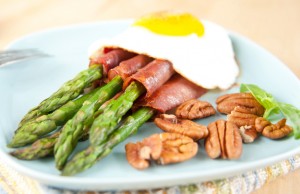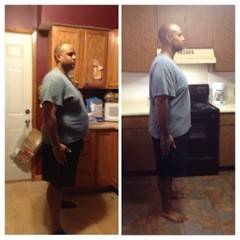Paleo diet: Is eating like cavemen best for our health?

Before there were packaged goods, processed foods, GMOs and an ongoing debate between organic or not, there was dirt, seeds, water and roaming animals. It may be hard to consider now, but the dawn of man produced hunters and gatherers and humans had to get their own food – not by heading to the supermarket.
There were no sprays to kill insects, no chemicals or genes added or modified. No extra-large tomatoes or vibrant yellow bananas. Food was simple. It was either found, picked or hunted. And although there weren’t doctors or research scientists to confirm the benefits of such eating, it seems that when it comes to dietary habits, eating like our ancestors has some merit.
Diets come and diets go, but one in particular seems to have staying power and for good reasons as well. It’s based on eating similar to that of prehistoric man and it’s being touted as one of the best way to eat. It’s called the Paleo diet.
What is the Paleo diet?
 The Paleo diet was created by Loren Cordain, a now-famous author, speaker and professor of health and exercise science at Colorado State University, who specializes in disease and diet. The Paleo diet itself reflects food items and methods of eating similar to our Stone Age ancestors – that’s right, this diet is framed around eating like cavemen. Through scientific research and peer-reviewed studies, Cordain has uncovered many health benefits to eating the Stone Age way.
The Paleo diet was created by Loren Cordain, a now-famous author, speaker and professor of health and exercise science at Colorado State University, who specializes in disease and diet. The Paleo diet itself reflects food items and methods of eating similar to our Stone Age ancestors – that’s right, this diet is framed around eating like cavemen. Through scientific research and peer-reviewed studies, Cordain has uncovered many health benefits to eating the Stone Age way.
There are seven premise on which the Paleo diet guidelines are based:
- High protein
- Low carbohydrates and low glycemic index
- High fiber
- Moderate to high fat intake – monosaturated and polysaturated fats with omega-3s and 6s
- High potassium, low sodium
- Net dietary alkaline balances dietary acid – some foods produce acid (meat) and others are alkaline (fruits and vegetables). Eating a balance of both alkaline and acid foods can have positive health effects.
- High intake of vitamins, minerals, antioxidants and plant phytochemicals.
As you can see, there isn’t much room for fast-food, packaged foods or sweets. If it wasn’t eaten in the Stone Age, chances are you can’t eat it on the Paleo diet.
We’ll go into further detail, but the Paleo diet food list includes:
- Fruits
- Vegetables
- Lean meats
- Seafood
- Nuts and seeds
- Healthy fats.
On the other hand, you must avoid:
- Dairy
- Grains
- Processed foods and sugars
- Legumes
- Starches
- Alcohol.
You may question the foods to avoid list because you’ve probably heard how grains are good for heart health and the occasional red wine packs antioxidants. But based on Cordain’s research, they just aren’t included.
So far, if this seems too challenging, let’s further outline some of the benefits to see if going Paleo is worth it.
Health benefits of the Paleo diet
Some benefits right off the bat to the Paleo diet are that you will be eating “cleaner.” This means you won’t be ingesting modified, pesticide-laden or processed foods. This style of eating has always been recognized as beneficial.
Another benefit is that foods like fruits, vegetables, oils and nuts can offer many nutrients which have been shown to combat inflammation. You will also feel fuller for longer because of your intake of fats and protein, so you may lose some weight as well. This is beneficial because being overweight is linked to many health risks such as hypertension and diabetes.
Paleo diet food list
 To provide you with more examples of the types of foods you can enjoy while on the Paleo diet, here is a detailed outline of the Paleo diet food list:
To provide you with more examples of the types of foods you can enjoy while on the Paleo diet, here is a detailed outline of the Paleo diet food list:
- Meat: Grass-fed beef, chicken, lamb, turkey, pork, etc.
- Fish and seafood: Salmon, shrimp, trout, shellfish, etc.
- Eggs
- Vegetables: Kale, peppers, onions, etc.
- Fruits: Avocados, tomatoes, apples, bananas, berries, etc.
- Nuts and seeds: Almonds, walnuts, cashews, pumpkin seeds, sunflower seeds, etc.
- Healthy fats and oils: Olive oil, coconut oil, avocado oil
- Salt and spices: Sea salt is best.
Vegetarian Paleo diet
Although the Paleo diet focuses on high protein intake, vegetarians can also embark on the trendy diet with some simple modifications which would still allow them to get in their protein minus the meat.
Some options for a vegetarian version of the Paleo diet include eating more eggs for additional protein, adding in grains like quinoa and hemp seeds along with sprouted beans and legumes. Although many of these suggestions go against the core Paleo diet, they are necessary for vegetarians to consume enough protein needed to be successful with the diet.
Guidelines if you’re considering the Paleo diet
If you’d like to try the Paleo diet and want to start creating a Paleo diet meal plan, there are some considerations to keep in mind.
Consult your doctor
First and foremost, if you are a senior, get the OK from your doctor, more so if you already have an underlying medical condition or are taking medications. Sometimes a change in diet can influence the effectiveness of medications and make health concerns worse.
Talk with the Paleo diet support community
If you do receive the go-ahead from your doctor, know that the Paleo diet offers a support community where you can talk with others about any issues or struggles you are having with the diet. This community can help you stay on track and offers up some great meal plan ideas so you don’t get bored. Remember, variety is key you’re less likely to stick to a diet if you’re bored of it.
Good bye to modern food
Another large consideration of the Paleo diet guidelines is that you’ll be giving up modern food. So say goodbye to anything that comes from a box, jar or packaging because it’s not an option.
Not a weight loss diet
Furthermore, Cordain himself notes that the Paleo diet is not a springboard to healthier eating, the Paleo diet is a lifestyle and something you can stick with for the long haul. So although you may lose weight on the diet, it’s not meant to be your kick-start to dropping pounds.
We have evolved
Keep in mind, too, that we’re evolved since the Stone Age. We don’t have to hunt for food and so we can get it in abundance whenever we want. Also with the rise of technology and changes in farming, it may not always be easy to follow the Paleo diet 100 percent, so don’t be hard on yourself if some options simply aren’t available.
It can be hard and needs committment
The Paleo diet can be hard but it becomes easier once you involve yourself and become educated. We’re not trying to say that the Paleo diet is foolproof and should be the way everyone eats, but if you can make an informed decision based on your needs then that is enough to help you stick with the program.
Some elements are not evidence based
The Paleo diet has a lot of good qualities with its focus on whole foods, lean meats, vegetables, fruits and healthy fats; however, the evidence for excluding dairy, legumes and grains isn’t strong to date. We do know that a one-size-fits-all approach is not the answer and such strict foods to avoid won’t likely hold up for the long-term.
Our message to you is we completely support healthy eating and everything is OK in moderation. There are great takeaways from this diet that you may want to try. Start with baby steps and just try to take out sugars and processed foods first. Essentially eat the way that’s best for you – we won’t tell anyone if you sneak in a piece of healthy dark chocolate!
-
Tips About How You Can Lose Belly Fat
If you wish to lose belly fat then you m
-
Dietary Weapons Of Mass Distraction WMD
As hoards of low-carb proponents invade the nutritional landscape, the
-
Fat loss Questions – Belly fat and Diet
I manage weight reduction questions about tummy fat and diet from my f
-
Aspartame vs. Sugar – Is One Any Better?
If you’re focused on weight loss, counting calories may be some
-
The Proper Attitude to Losing Weight
Contrary to common belief, there is actually no right way to diet a
-
Build Stronger Bones With Calcium Supplements
Calcium has become synonymous with strong bones, and it is one of the
- DON'T MISS
- Natural Weight Balancing
- Lose Or Gain As Much Weight As You Choose
- Top 5 Lies the Raw Food Experts Don't Want You To Know
- San Ramon Quick Weight Loss Techniques
- How To Lose Baby Weight With These 5 Easy Tips
- Losing Weight And Keeping It Off
- What You should Know About Liquid Diet Weight loss
- Turn on your Weight Loss Hormones
- Oral HCG Drops For Obesity Treatment Can Help
- Losing Obesity Weight Quickly and Healthily




